- Pet Food Dispenser With Camera: The Ultimate Way to Monitor Your Pet’s Meals! - November 16, 2023
- Automatic Pet Feeder With Timer: A Time-Saving Solution for Busy Pet Owners - November 16, 2023
- Pet Tracker for Small Dogs: Discover the Ultimate Solution for Tracking Your Furry Friend - November 16, 2023
A hub for smart bulbs is a central device that connects and controls multiple smart bulbs in a home. Smart home technology has taken the world by storm, offering convenience, efficiency, and improved energy management.
One popular aspect of smart homes is the ability to control lighting with ease. Smart bulbs, equipped with LED technology, can be controlled wirelessly through a smartphone or voice commands. However, when it comes to controlling multiple bulbs simultaneously, a hub for smart bulbs becomes essential.
Acting as a centralized device, the hub connects to the home’s Wi-Fi network, enabling communication between the bulbs and the control device. This hub serves as a bridge, allowing users to group and control multiple bulbs simultaneously, schedule lighting routines, and even sync the lighting with other smart devices. We will explore the features and benefits of a hub for smart bulbs and how it enhances the smart lighting experience in your home.
Understanding The Basics Of Smart Bulbs
In the world of smart home automation, one of the most popular devices is the smart bulb. Smart bulbs are revolutionizing the way we illuminate our homes, offering a wide range of benefits that traditional light bulbs simply can’t match. But what exactly is a hub for smart bulbs? In this article, we will delve into the basics of smart bulbs, explore their key features and benefits, and understand how they work with wireless technology.
Key Features And Benefits Of Smart Bulbs
Smart bulbs are not your ordinary light bulbs. They are equipped with advanced features that make them highly versatile and convenient, adding a new level of functionality to your home lighting system. Here are some key features and benefits of smart bulbs:
- Remote Control: With smart bulbs, you have the power to control your lights from anywhere in the world using a smartphone app. Whether you’re lying in bed or away on vacation, you can easily turn your lights on and off or adjust their brightness and color.
- Customizable Lighting: Smart bulbs offer a wide range of color options, allowing you to create the perfect ambiance for any occasion. Whether you want a warm, cozy atmosphere or a vibrant, party setting, you can easily customize your lighting to suit your mood.
- Scheduling and Automation: With the ability to schedule your lights to turn on and off at specific times, smart bulbs offer a convenient way to automate your lighting. You can program your lights to gradually brighten in the morning to wake you up gently or automatically dim in the evening to create a relaxing environment.
- Energy Efficiency: Smart bulbs are designed to be energy-efficient, helping you save on your electricity bills. They use LED technology, which consumes less energy compared to traditional incandescent bulbs.
- Integration with Other Smart Devices: Smart bulbs are typically compatible with other smart devices, such as voice assistants like Amazon Alexa or Google Assistant. This means you can control your lights using voice commands, adding an extra level of convenience to your smart home ecosystem.
How Smart Bulbs Work With Wireless Technology
Smart bulbs rely on wireless technology to communicate with other devices and offer a seamless user experience. They connect to a central hub or directly to your home’s Wi-Fi network, enabling you to control them remotely using your smartphone or other compatible devices.
Here is a simplified explanation of how smart bulbs work with wireless technology:
- The smart bulb connects to a central hub via wireless protocols like Zigbee or Z-Wave, or directly to your Wi-Fi network.
- The central hub acts as a bridge between your smart bulb and other devices in your smart home system.
- Once connected, you can control the smart bulb using a smartphone app, voice commands, or automation routines.
- The smart bulb receives commands wirelessly and adjusts its settings accordingly, whether it’s turning on or off, changing colors, or adjusting brightness.
In summary, smart bulbs offer a myriad of features and benefits that enhance the way we illuminate our homes. They provide remote control, customizable lighting options, scheduling and automation capabilities, energy efficiency, and integration with other smart devices. By understanding how smart bulbs work with wireless technology, you can take full advantage of their functionalities and create a smarter, more convenient living environment.
The Role Of A Hub In Smart Bulb Systems
A hub is a vital component in a smart bulb system, acting as a central control unit that enables communication between the bulbs and other devices. It allows users to easily manage and customize their lighting preferences, creating a seamless and automated smart home experience.
Explaining The Purpose And Function Of A Hub
A hub is a crucial component in a smart bulb system that plays a vital role in simplifying and enhancing the functionality of your smart lighting setup. It acts as a central command center, connecting and controlling all the smart bulbs in your home or office. The primary purpose of a hub is to establish a seamless communication network between your smart bulbs and other compatible devices, such as your smartphone, tablet, or smart assistant.
By acting as a bridge between your smart bulbs and the controlling devices, a hub enables you to enjoy a range of advanced features and functionalities. Essentially, the hub serves as the brain of your smart bulb system, allowing you to take full advantage of the automation, customizability, and convenience offered by smart lighting technology.
How A Hub Connects And Controls Smart Bulbs
The process of how a hub connects and controls smart bulbs is quite straightforward. Once you have set up your hub and connected it to your Wi-Fi network, it will automatically start scanning for compatible smart bulbs in its vicinity. Using wireless protocols such as Zigbee or Z-Wave, the hub establishes a secure connection with each smart bulb it discovers.
Once the connection is established, the hub acts as a mediator, facilitating two-way communication between your controlling devices and the smart bulbs. This communication allows you to send commands to individual bulbs or groups of bulbs, controlling their on/off status, brightness level, color output, and various other settings.
The hub also enables you to create schedules, scenes, and automation routines for your smart bulbs. You can easily program your lights to turn on at specific times, dim during movie nights, or even sync with your favorite music to create immersive lighting experiences.
In addition to controlling your smart bulbs directly from your smartphone or tablet, a hub may also provide voice control capabilities. By integrating with popular smart assistants like Amazon Alexa or Google Assistant, you can control your smart bulbs with simple voice commands, making your smart lighting system even more intuitive and effortless to use.
Compatibility And Integration With Smart Home Systems
When it comes to creating a smart home setup, one of the key components to consider is a hub for smart bulbs. This hub acts as a central control unit, allowing you to manage and integrate your smart bulbs with other smart devices in your home. In this article, we will explore the importance of compatibility and integration with smart home systems when choosing a hub for your smart bulbs.
Compatible Smart Home Systems And Protocols
Before diving into the integration process, it is crucial to ensure that your chosen hub for smart bulbs is compatible with your existing smart home systems and protocols. The last thing you want is to invest in a hub that cannot communicate with your other devices. Here are some of the most popular smart home systems and protocols that you should look for compatibility:
- Amazon Alexa
- Google Assistant
- Apple HomeKit
- Samsung SmartThings
These systems not only give you voice control options but also allow for seamless integration with an array of smart devices beyond just smart bulbs. Make sure to check the hub’s specifications and compatibility list to ensure it meets your needs.
Integration Process And Benefits
Once you have confirmed compatibility, the integration process with your smart home system is the next step. This process may vary depending on the hub and smart home system you are using, but it generally involves the following steps:
- Install the hub and connect it to your home network.
- Download and install the compatible app on your smartphone or tablet.
- Follow the app’s instructions to add the smart bulbs to your hub’s network.
- Configure the settings and preferences for your smart bulbs within the app.
The integration process typically takes just a few minutes and does not require any technical expertise. Once integrated, you can experience the following benefits:
- Centralized Control: With a hub for smart bulbs, you can control all your bulbs from a single app or smart home system, offering convenience and ease of access.
- Automation: Integrating your smart bulbs with your smart home system allows you to automate various tasks, such as turning lights on/off based on occupancy, time of day, or sensor triggers.
- Scenes and Routines: Create custom scenes or routines to set the perfect ambiance for different occasions, like movie nights or romantic dinners.
- Voice Control: Integration with popular voice assistants, such as Amazon Alexa or Google Assistant, enables you to control your smart bulbs using simple voice commands.
By investing in a hub that is compatible with your smart home system and integrating your smart bulbs seamlessly, you can unlock the full potential of your smart home setup, making your life more convenient and comfortable.

Credit: www.cnet.com
Advantages Of Using A Hub For Smart Bulbs
A hub for smart bulbs offers several advantages for users. It serves as a central control unit, allowing users to manage and customize their smart lighting system easily. With a hub, users can enjoy seamless integration, improved automation, and enhanced security features for their smart bulbs.
When it comes to embracing the convenience and versatility of smart lighting, a hub for smart bulbs is an essential component. Acting as the central control unit for all your smart bulbs, a hub offers a multitude of advantages that enhance your overall smart home experience. Let’s dive into these advantages:
Enhanced Control And Customization Options
With a hub for smart bulbs, you gain enhanced control and customization options that allow you to create the perfect lighting ambiance in your home. Whether you want bright, energizing lights for the morning, soft and dim lights for a cozy evening, or colorful lights for a festive occasion, the hub enables you to easily adjust and customize the lighting according to your mood and preferences.
Using the hub’s intuitive mobile app or voice commands, you have the power to control all your smart bulbs individually or as a group. This level of control extends to adjusting brightness levels, selecting specific colors, and even setting schedules to automate your lighting based on your daily routine.
Moreover, a hub enables you to create unique lighting scenes that can be activated with a single tap or command. For example, you can have a “movie night” scene where the lights dim, the shades close, and the projector turns on, all with just a simple command. This level of control and customization ensures that your smart lighting seamlessly integrates into your lifestyle, providing convenience and comfort at your fingertips.
Seamless Integration With Other Smart Devices
In addition to offering enhanced control and customization options, a hub for smart bulbs provides seamless integration with other smart devices in your home. This integration opens up a world of possibilities and enhances the overall functionality of your smart home ecosystem.
When your smart bulbs are connected to a hub, you can integrate them with other smart devices such as motion sensors, smart switches, and even voice assistants like Amazon Alexa or Google Assistant. This means you can set your lights to automatically turn on when you enter a room, have them respond to motion, or even control them with your voice commands.
The ability to integrate smart bulbs with other devices enables you to create smart home routines and automation scenarios. For example, you could have the lights turn on gradually in the morning to simulate a sunrise, or have them automatically turn off when you leave home to save energy. By seamlessly integrating your smart bulbs with other devices via a hub, you can create a truly connected and intelligent home environment.
Choosing The Right Hub For Your Smart Bulb Setup
If you’ve decided to upgrade your lighting system with smart bulbs, you’ll need a hub to control them efficiently. A hub acts as the central command center for your smart bulbs, allowing you to control them remotely using your smartphone or voice commands. Selecting the right hub is crucial to ensure compatibility, functionality, and ease of use. In this article, we will explore the factors to consider when choosing a hub for your smart bulb setup and popular hub options available in the market.
Factors To Consider When Selecting A Hub
When selecting a hub for your smart bulb setup, you need to take into account several factors to ensure it meets your specific requirements. Here are the key factors to consider:
- Compatibility: Before purchasing a hub, ensure it is compatible with the smart bulbs you plan to use. Some hubs work only with specific brands or protocols, so it’s essential to check for compatibility.
- Connectivity: Consider the connectivity options provided by the hub. Most hubs support Wi-Fi and Bluetooth, but some may also offer Zigbee or Z-Wave connectivity.
- Control Options: Evaluate the control options available with the hub. Does it have an intuitive smartphone app? Can it be integrated with popular voice assistants like Amazon Alexa or Google Assistant?
- Scalability: If you plan to expand your smart bulb setup in the future, choose a hub that allows for easy scalability. Make sure it can support a sufficient number of bulbs and devices.
- Security: Security is paramount when it comes to smart home devices. Look for a hub that offers robust security features and encryption protocols to ensure your data and privacy are protected.
Popular Hub Options Available In The Market
With the rising popularity of smart home technology, there are numerous hub options available in the market. Here are some of the top choices:
| Hub | Compatibility | Connectivity | Control Options | Scalability |
|---|---|---|---|---|
| 1. Amazon Echo Plus | Works with a wide range of smart bulbs including TP-Link, Philips Hue, and LIFX | Wi-Fi, Zigbee | Voice control via Alexa, smartphone app | Supports a large number of devices |
| 2. Samsung SmartThings Hub | Compatible with various smart bulbs, sensors, and other devices | Wi-Fi, Zigbee, Z-Wave, Bluetooth | SmartThings app, voice control with Google Assistant or Alexa | Capable of handling multiple devices |
| 3. Philips Hue Bridge | Specifically designed for Philips Hue smart bulbs | Wi-Fi, Zigbee | Hue app, voice control with Alexa or Google Assistant | Supports up to 50 Philips Hue devices |
Frequently Asked Questions On What Is A Hub For Smart Bulbs
What Is A Hub For Smart Bulbs?
A hub for smart bulbs is a device that acts as a central control system for your smart bulbs. It allows you to connect and control multiple smart bulbs simultaneously, adjusting their brightness, colors, and schedules from a single app or voice command.
It eliminates the need for individual bulb control and offers additional features like automation and integration with other smart home devices.
Do I Need A Hub For Smart Bulbs?
Whether you need a hub for smart bulbs depends on the type of bulbs you have. Some smart bulbs, like those using Zigbee or Z-Wave technology, require a hub for connectivity and control. However, Wi-Fi-based smart bulbs can be controlled directly without a hub, using your home Wi-Fi network.
If you plan to have multiple smart bulbs and want advanced control features and integration, a hub can be beneficial.
What Are The Advantages Of Using A Hub For Smart Bulbs?
Using a hub for smart bulbs offers several advantages. Firstly, it provides centralized control, allowing you to easily adjust settings for multiple bulbs without individually accessing each one. Secondly, hubs often offer advanced features like automation, scheduling, and integration with other smart devices, enhancing the overall smart home experience.
Lastly, a hub can potentially increase the range and stability of connectivity, ensuring seamless communication between the bulbs and the control system.
Can I Use Different Brands Of Smart Bulbs With A Hub?
Yes, most hubs for smart bulbs support multiple brands and models, allowing you to mix and match different bulbs. Hubs use standard communication protocols like Zigbee or Z-Wave, which are compatible with a wide range of smart bulbs from various manufacturers.
However, it’s always recommended to check the compatibility list provided by the hub manufacturer to ensure your specific bulbs are supported.
Conclusion
To wrap it up, a hub for smart bulbs serves as the central control unit for your smart lighting system, allowing seamless integration and control. With its ability to connect and communicate with multiple smart bulbs, you can effortlessly manage your lighting preferences through a single platform.
Experience the convenience, energy efficiency, and customization possibilities that a hub brings to your smart home. Explore the endless possibilities of creating the perfect ambiance with a hub for smart bulbs.


